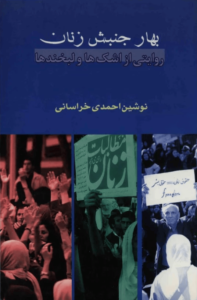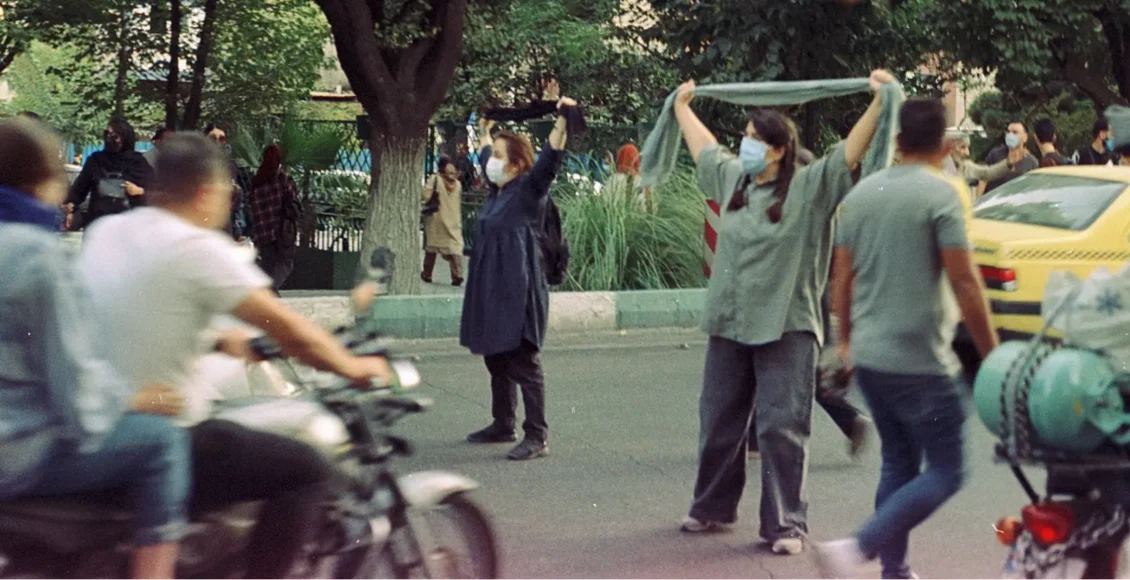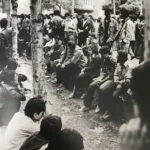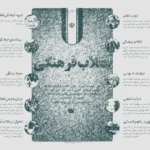/Book Review | Reading Time: 15 minutes
From Spring of the Women’s Movement
to Post-Jina Era
Atena Kamel | December 15, 2024
© Background Photo by Mohammad Moghadasi
ISSN 2818-9434

The book Spring of the Women’s Movement: A Narrative of Tears and Smiles, as its title suggests, is a personal archive of the years of the emergence and expansion of the women’s movement after the 1979 Revolution put together by one of the feminists participated in it. In the introduction, Nooshin Ahmadi Khurasani writes, “No need to emphasise that my focus in this book has been on actions and campaigns in which I have been involved” (2012: 10). She emphasizes that she has made every effort to remain a narrator and not a judge in this book. This means that the emotions her body has experienced are not included in her recordings of events. As a result, we are dealing with a personal archive that is narrated in a non-personal manner.
However, feminist knowledge production, with its concern for documenting history, cannot help but be preoccupied with mobilizing and reorganizing forces among the future generation. While this book archives key struggles, experiences, and strategies of the women’s movement from the late 1990s to 2009, it may inspire the reader to extend the narrative and engage with the events that follow the conclusion of the archive. The driving force behind the creation of this archive stems from the author’s emotional experiences and her full-time involvement in protests, alliances, and ruptures within the movement. Therefore, it can be said that individual or private emotions are not sidelined in this book and more importantly, like any feminist archive, it goes beyond merely narrating the history of the events and invites the reader to pragmatistic reflection.
The book is divided into two main sections: The first section (the first two chapters) narrates the resurgence of women’s activism from the 1990s to 2003, following its suppression in the post-1979 Revolution era, with a focus on the formation of the Women Publishers Collective and the Women’s Cultural Center. The second section examines various women’s groups, and the alliances formed during the period from 2003 to 2009, marking the peak of the movement.
Spring of the Women’s Movement offers a compelling reflection on the history of the women’s movement after the 1979 Revolution. It traces the journey of women’s activism, from the closed political climate and cautious activism of the tumultuous and tragic 1980s to the emergence of diverse women’s groups, holding the public March 8th events, street protests, alliances, and internal disagreements of the 1990s and 2000s. This makes the book an essential reading for anyone seeking a deeper understanding of the current state of the Iranian women’s movement.
I use the book as a lens to examine the current situation and to revisit questions about the past through the perspective of the post-Jina moment. After all, the act of narration continually reshapes both the past and the present. I explore which concepts and ideas might illuminate the changes in the women’s movement if we trace it from where the author leaves off in this book to the 2010s and beyond the Jina uprising. How should we interpret the [lack] of alliances today? Can concepts such as ‘display society,’ ‘celebrity culture,’ social platforms, and individualism in activism help us better understand the transformations in feminist activism in Iran during this period? Furthermore, how have the dynamics of organization, mobilization, and communication between feminists inside and outside the country changed? I have structured these questions around five key concepts: shifts in the political landscape, changes in how activists communicate, evolving dynamics between the diaspora and those within the country, the reconfiguration of the politics of emotions, and the shift in activism from formal to informal spheres. While I do not suggest that these concepts provide definitive answers to all the questions posed, I hope they have served to refine the inquiries and highlight the broader issues at stake.
From Women’s Circles to Group Alliances in a Favorable Climate
As mentioned, the first part of the book focuses on the gradual formation of women’s groups and their collective actions, which emerged from the tense political climate of the 1980s and continued into the 1990s. The second part shifts its attention to the consolidation of power, transitioning from independent groups to the inter-group level and the formation of alliances between women’s groups, starting in the mid-point of Mohammad Khatami’s second term in 2003 and continuing until the end of Mahmoud Ahmadinejad’s first term in 2009.
So, the overarching theme of the book is to trace the process of uniting capabilities and forces—from the individual level to the group level, and from group-based efforts to inter-group solidarity driven by feminist coalitions.
Collaboration and interaction between groups within a movement is a complex issue, particularly due to the diversity of groups in terms of their differing priorities and approaches to activism. Alliances are formed by creating a collective identity, networking, shared values, and a commitment to a common goal, all of which emerge within a favorable space-time context that fosters these values. This conducive context does not always correspond to favorable political opportunities; challenges such as threats, widespread repression, or counter-movement actions can also energize movements, attract supporters, and even improve their chances of success. Therefore, both political threats and opportunities can push activists toward coalition-building. Spring of the Women’s Movement narrates the formation and dissolution of coalitions and alliances in the context of both political opportunities and threats.
During the period from 2003 to 2009, coalition-building emerged as the primary strategy of the women’s movement. It all began with the founding of the “Forum for Dialogue Among Women” (Ham-andishi Zanan) in 2003, which provided a foundation for the formation of other coalitions and catalyzed many collective protest actions. The notable coalitions of this period include the “One Million Signatures Campaign,” the most enduring and widespread initiative launched in 2006; the “Coalition Against the Family Protection Bill” in 2008; and the “Coalition to Raise Women’s Demands in Election” during the 2009 presidential election. The second coalition stood out for its inclusion of diverse forces, including reformist and conservative women within the political establishment, as well as secular, leftist, and religious activists from outside the government. Khorasani describes the last coalition as “the most mature and sophisticated coalition” (2012: 11); Unlike its predecessors, this coalition was swiftly formed during the brief window of openness in the pre-election season.
Aa Khorasani explains, women activists often gained greater visibility and prominence for their discourse during critical junctures when they succeeded in building intra-group consensus around a common goal or demand. However, in the years that followed, the coalition strategy did not endure, particularly among the new generation of feminists [1]. This prompts the question: what factors hindered its continuation in the late 2010s? To explore this, it is helpful to view coalition-building as a spectrum. At one end lies integration, where groups unify into a single organizational structure and identity; in the middle, coalitions where groups collaborate while maintaining their independence; and at the other end, group communication through loose networks. Over time, the women’s movement appears to have gradually shifted from coalition-building toward network-based communication as it approaches the present day. These networks, marked by diversity and weak ties, primarily serve to exchange information during key moments, but seldom engage in substantial collective action or pursue specific, goal-oriented activities.
The Shift Toward Individual Activism and Social Media Networks
A look at key activist initiatives in the early 2010s, including campaigns against mandatory hijab like White Wednesdays (Charshanbe-haye Sefid), My Stealthy Freedoms (Azadi-haye Yavashki), and Girls of Revolution Street (Dokhtran-e Enqelab) in 2017, highlights their main characteristics, including reliance on visual and performative language, individual activism, and social media networks. Feminist activism no longer relies on collective efforts to mobilize resources through collaboration with other activists in the field; instead, it is increasingly facilitated by digital platforms[2].
The campaign against mandatory hijab, initiated by Masih Alinejad, became her personal brand on social media, focusing on a single individual. Unlike the One Million Signatures and No Stoning Law campaigns (2006), which involved diverse groups with no single leader (coalition-building), campaigns like My Stealthy Freedom and White Wednesdays attracted many women from various backgrounds but were centered around the personal brand and political stance of the campaign leader. The political stance of the women joining the campaign was predetermined, which led to the exclusion of other women opposing mandatory hijab with differing political. In this way, the broader participation was limited as the weakly networked activists were drawn into a political stance that resulted in severe punishment in the case of women whose shared unveiled pictures were identified by the authorities in Iran. However, it should not be overlooked that in the dominance of individualistic and performative actions, personal embodied experiences were quickly linked to the collective and everyday experiences of women. As a result, the “suffering of Iranian women” gained greater prominence and resonance, both nationally and transnationally.
Online campaigns were less focused on negotiating or coordinating efforts with activists or feminist scholars, a common practice in earlier women’s movements. On the contrary, they often made activists more cautious of one another. Digital media operates with its own internal logic; it is not merely a tool serving feminist goals but imposes its structure on activism. Features like likes, favorites, follower counts, post visibility algorithms, and story views define the logic that shapes the activism space for users. This same logic often pushes activists toward celebrity-like statuses for greater impact. Networked activism (based on social media networks) has become the dominant form of feminist activism, which is a bottom-up activity without rigid leadership or organizational structure. Instead, it revolves around showcasing or narrating shared experiences of discrimination and abuse, particularly through the sharing of emotions and women’s agencies.
However, 2010s were not devoid of on-the-ground feminist groups that came together around specific issues. The key difference was that collective organizing no longer primarily aimed at legal reform or policy changes. Instead, many groups concentrated on social issues, seeking to raise awareness or improve conditions for women at the local level. For example, some groups
addressed violence against women and worked to increase gender awareness. Some traveled to various cities and neighborhoods to hold workshops. Other women activists tackled the lack of safe houses for abused women by establishing private shelters. In 2018, a group protested sexual violence in public spaces through fieldwork, awareness campaigns, poster installations, and the creation of a website called “Harass Watch,” which became a hub for interactions and connections among feminists. Bidarzani website, is another notable example which, through years of collective efforts in publishing feminist content has turned to a reputable feminist platform that remains active today.
The #MeToo (Man-ham) movement, emerged in the summer of 2020 in Twitter by Persian language twitters, marked a turning point in both revitalizing the movement and challenging the networked activism. The collective efforts to amplify sexual harassment narrations were multifaceted, involving support for disclosures, confidentiality, fact-checking, legal concerns about consensual relationships, collaboration with feminist platforms, and issues of personal branding. These complexities made reliance on the loose connections of social-media activism insufficient.
The movement highlighted the role of feminists who contributed through their time, credibility, emotional support, and collective work skills, those who were familiar with the previous generation’s skills, and had relied on a minimum level of organization and trust-based relationships. A movement against sexual and gender-based violence could not thrive solely online. Narrators and even accused individuals required consultation and negotiation with feminists and platforms, while activists needed to collaborate to manage stories effectively. The dynamic space among feminists during the #MeToo movement, after years of dormancy, created fertile ground for critically examining narration strategies—though this momentum was disrupted by the protests of 2022. Thus, networked activism, as seen in #MeToo, only managed to operate at the intersection of online and offline spaces, demonstrating the real necessity of intertwining the two spheres.
Feminists Inside and Outside the Country
Networked activism changed the national scale of activism, reshaping relationships between feminists inside and outside the country. Started in the 1979 Revolution and the subsequent migration of some feminists, the relation has evolved over decades. Khorasani notes effective organic communication from the 1990s to the mid-2000s, whereas before the mid-1990s, those outside had greater influence on insiders. Journals like Nimeh-ye Digar (The Other Half) and Avaye Zan (Woman’s Voice), published abroad, were widely read by feminists in Iran, and discussions at the annual Conference of Iranian Women’s Studies Foundation, organized by Golnaz Amin in the U.S. and Europe, also gained attention.
Hashemi Rafsanjani’s foreign policy (1989–97) to engage with international community strengthened feminist connections, remaining stable until 2005. However, from the mid-2000s, such interactions faced accusations of espionage or collaboration with enemy, forcing these relationships into a more security-focused dynamic that continues today. The rise of digital media in this political climate complicated inside-outside communications. While online platforms facilitate connections, differing activist strategies to achieve the same goals, shaped by contrasting conditions, led to greater boundary-making and distancing between the two groups.
The Nobel Peace Prize provides an example of these controversies: Shirin Ebadi’s Nobel Prize in 2003 “breathed new life into the women’s movement and enhanced its global credibility” (Ahmadi Khorasani: 153-4). However, Narges Mohammadi’s Nobel Peace Prize in 2023 have not such a strong impact on the women’s movement and its activists, while transnational solidarities are more important, both in political and women’s right spheres, in 2023 rather than 2003.
Ebadi’s award coincided with a pivotal moment when organized women’s activism within the country was taking significant leap toward collective action, when the dynamics of collaboration were becoming clearer, enabling activists to harness the momentum and broaden their efforts.
Global awards, however, only serve as effective capital at the national level when the socio-political climate is conducive. The initial impact of Ebadi’s Prize was amplified through its mediation by feminist groups and its circulation among women activists, both domestically and abroad. This process enhanced the award’s value, contributing to the credibility and visibility of the Iranian women’s movement on both national and international stages. Mohammadi’s prize was awarded during a period when the movement had been significantly weakened. While her unwavering resilience under the pressures of imprisonment highlights her credibility, there is no movement to capitalize on her achievement and even her bilingual Instagram page (in Persian and English) reflects a focus on addressing international organizations and foreign governments with her demands and protests.
I introduced the comparison of the two Nobel Peace Prizes awarded 20 years apart within the context of my discussion on feminists inside and outside the country, to argue that social movements need to recognize the importance of all scales and have strategies to increase their power and influence at different scales. By scale, I mean the conventional local, national, and global dimensions. These scales are interconnected through specific goals and integrated by certain interests. In recent years, due to governmental restrictions, a kind of rupture has emerged between feminists working inside and outside the country; whereas, in the 2000s, academic feminists abroad had connections with activists inside the country, and there was a dialogue between them as they could travel to Iran, which has been disrupted in recent years and we did not see enough initiative to prevent the rupture. I believe that the rupture could not be explained only by the increased securitization of the environment, as if the activists had no agency to change it. I think feminists living abroad could do better in these years of extreme pressures in Iran.
Connections of outside researchers with locals is particularly illuminating here, and I highlight it to strengthen feminist collaborations in this field. In recent years, many PhD students and professors affiliated with universities in the U.S. and Europe have explored topics such as gender relations, the women’s movement, sexuality, justice-seeking activism, and the Jina uprising through collaboration with local activists. They often gather data by interviewing and working with local feminists, women involved in protests, and other groups, subsequently publishing their findings and presenting them at international conferences. However, the securitized environment has resulted in a one-way flow of collaboration from Iran to the global academic community. While these researchers may critique or praise local activists in their writings, they frequently fail to address the need to create opportunities for them within these academic processes. Concerns about jeopardizing their ability to travel to Iran if they actively support local activists are understandable, but the reality is that the security risks in such collaborations are mutual. Nonetheless, these risk concerns do not justify one-way research relationships.
I would like to redirect my focus from the scale of activism back to my initial question about the lack of coalition strategies in the 2010s. I argue that coalitions cannot be effectively formed in the online space without the foundation of interpersonal relationships, face-to-face meetings, and ongoing interactions. The shift to networked and online activism is not merely a change in communication tools but has also transformed the nature of the women’s movement. Digital media have reduced the strong, face-to-face interactions, group connections, and interpersonal relationships that once characterized the movement. In their place, they have fostered collective actions marked by greater spontaneity and flexibility, amplifying collective emotions on a broader scale and maintaining a close connection to women’s daily lives. However, this shift has come at the cost of a diminished capacity for collective organization.
The Politics of Emotions and Sustainability of the Emerging Communities
In recent years, we have frequently observed the significant role digital media plays in amplifying emotions. Experiences of discrimination, oppression, and the resulting anger rapidly spread across social networks. At times, as seen during the Jina uprising, anger driven by injustice sparked protest actions, with digital media amplifying and intensifying both the anger and the protests. During such protests, anger is often intertwined with feelings of joy and pleasure. Emotions have always shaped the experiences of oppression and protest in various ways. However, what has heightened the focus on emotions in recent years is the speed at which they are transmitted through social media and their circulation among a wide audience. This rapid emotional exchange has created new potentials for mobilization and connection—both nationally and transnationally. Anger no longer stays confined to the scene of protests; it gains credibility through political groups and activists, gaining recognition. The legitimacy of anger over issues like mandatory hijab, ethnic deprivations, and futureless youth requires emotional engagement and a shift in understanding between those previously unaware of such injustices and the affected groups. The Jina uprising exemplifies how emotion fueled protest, spreading rapidly within the country. Thus, it is no surprise that the movement has been criticized for lacking collective structures and long-term political goals.
A comparison of the coalition campaigns of the 2000s and digital media activism in terms of the politics of emotions reveals similarities. Both were sparked by anger and a sense of injustice, but also included joy in defiance, happiness in small victories, hope for change, fear of risks, and love for the cause. While anger often mobilizes, “it is the combination of anger and joy that helps sustain movements” (Ransan-Cooper et al, 2018: 635). The Spring of the Women’s Movement, highlights both the tense coordination meetings and the overwhelming enthusiasm and hope following protests, March 8th public celebrations, and coalition solidarities (pp. 181, 189-191, 210-216).
During the Jina uprising, solidarity emerged at key moments, such as honoring victims—those injured with pellet wounds, imprisoned, or executed—and remembering the mass protest at Keshavarz Boulevard or Nika Shakrami’s tragic death. Short-term hope for a coalition among opposition figures abroad quickly faded, as it was never a genuine coalition. However, the question of building a coalition based on shared political commitment, despite differences, persists. Like the women’s movement of the 2000s, such a coalition could evolve through dynamic mobilization, challenging political structures and reshaping interpersonal relations.
The charters on women’s rights during the uprising failed to support coalition-building, as publishing them on social media couldn’t mobilize a broad female population. One of the charters included inactive or minimally engaged groups as supporters, leading to widespread criticism.
It is important to note that both political openness and repressive conditions can drive activists toward coalition-building. The feminist groups’ use of the brief favorable political climate before the 2009 election is an example of capitalizing on such conditions. However, research indicates that threats to democracy play a key role in coalition-building, and despite a decline in protest incidents, they can lead to unification. McCammon and Moon (2015: 329-330) argue that studies on the role of threats in coalition-building are more common than those focusing on the role of open political spaces. But are we fully aware of the necessity of forming alliances as a critical factor, particularly to overcome the challenging conditions we face, and how should we approach this?
Challenges of Rebuilding Activism: Formal vs. Informal Politics
I examined the features of feminist activism as described in The Spring of the Women’s Movement, and social factors that shaped them, and followed the changes that occurred after the 2009 crackdown. In this final section I emphasize on challenges of the new strategies taken by activists to cope with increasing authoritarianism in the system.
Rebuilding movements after repression presents activists with complex challenges. They often find themselves in unstable conditions, facing increased surveillance, migration, and the imprisonment of their peers. As a result, redefining goals, structures, and methods of action in such circumstances demands significant additional effort.”
Women’s activists in Iran faced challenges in rebuilding the women’s movement after the 2009 elections repressed civil society. Their efforts to restore the movement in the years that followed included campaigns like Change the Male-Dominated Image of Parliament in the fall and winter of 2015. Building on previous methods of campaigning, the initiative organized both young and older members into several working groups in Tehran and provincial cities. However, the campaign lost momentum due to increasing government pressure, ultimately marking the end of this type of activism within the women’s movement.
The activists became fragmented, with those determined to continue their work retreating into small group activities, while more individual women joined the civil disobedience against compulsory hijab. The decentralized nature of these small groups’ activism provided resilience, pushing them toward activities in the informal sphere of politics. Informal networks became a survival strategy in the repressive environment, emerging out of necessity rather than choice.
Informal politics and the growing disconnect with the government, which has intensified since the Jina uprising, are essential for the continuity of resistance and activism. However, such activism does not necessarily have the capacity to connect with broader societal actions. The main drawback of activism in the informal political sphere is the long-term marginalization of activists from society. This isolation can lead to the creation of detached and disillusioned enclaves of activists, who lose their ability to envision and pursue broader, future-oriented goals. These groups may become isolated islands, struggling to communicate, manage disagreements, and engage in collective action. As a result, they may become more consumed by internal tensions and less capable of fostering collaboration.
References
- McCammon, Holly J., and Minyoung Moon, 2015. “Social Movement Coalitions” in Della Porta, Donatella, and Mario Diani (eds.), The Oxford
handbook of social movements. Oxford University Press, 2015. - Ransan-Cooper, Hedda, Selen A. Ercan, and Sonya Duus. 2018. “When Anger Meets Joy: How Emotions Mobilize and Sustain the Anti-Coal
Seam Gas Movement in Regional Australia.” Social Movement Studies, 17 (6): 635–57.
- McCammon, Holly J., and Minyoung Moon, 2015. “Social Movement Coalitions” in Della Porta, Donatella, and Mario Diani (eds.), The Oxford
Endnotes
- One of their last efforts to shape a coalition in the post-2009 era [following the suppression of the Green Movement], was the Changing the Male Face of the Parliament campaign in February 2015 Parliament election. The campaign aimed to secure 30% female representation in parliament. The campaigners emphasized they would not rely on resources of political parties and institutions but depend on women organized within civil society to achieve this goal. They encouraged women to engage in the elections, both as candidates and voters. While the goal of 30% female representation in Parliament was not met, the 17 women elected (6% of total MPs) set a record for female presence in the history of the parliament in the Islamic Republic and reversed the downward trend of female representation in parliament since the fifth session (1995). This was the last campaign the older and younger activists collaborated in its promotion. The 2015 denial of NGO registration for the Women’s Citizenship Center (Kanon-e Shahrvandi Zanan), a key player in the campaign, along with the increasing pressures on other activists, marked the end of the familiar forms of campaigning aimed at rebuilding the women’s movement in the post-2009 era. ↑
- Using the term “activist” here does not imply elevating protesting women who joined campaigns against compulsory hijab to the level of activists but rather highlights the transformation of campaigns and feminist activism on a broader scale.










Comments are closed.